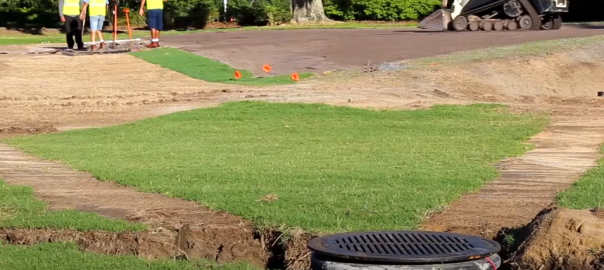For most Americans, talking about ground drainage is no where near their favorite subject. However, golf course drainage is a totally different monster. Its design is crucial to keeping the golf course up and running, even after heavy storms. It can determine whether or not a course is able to make money and be open for the day. While some of the systems may be more complicated than regular ground drainage and irrigation, it is important that golf course drainage systems are thoughtfully and thoroughly designed and maintained.
Drainage on a golf course is necessary to eliminate water from the play surfaces enabling it to stay usable during and sometimes after heavy downpours. Better drainage can often help avoid harm to the soil that may result as water piles up into puddles and is kept standing for too long. One of the earliest and most important considerations is where to direct and deposit run off water. If runoff water from the course is directed to enter existing drainage systems, it is imperative to make sure the existing system can handle the additional water and often times, permission will need to be obtained to use these existing systems. Surface drainage will reach into millions of gallons per month / year depending on environment conditions. If the golf course is part of a larger plan that may have major expense and construction consequences. Some people have concerns about the availability of usable water in the next few decades, especially as the world wide population increases. Having systems in place to help reuse runoff water from golf courses has the potential to make a big difference in the future.
The planning phase will commence with a site inspection, during which a site development plan will be drawn up to evaluate low points, cliffs, hills, watercourses, wetland areas and public facilities. There is also a need to recognize different forms of geology and soil, because they may influence how water sinks, flows and collects.
When designing the course, the grading will be shown using contour lines throughout the site plan. Where there is a sharp grade change, the surface water will collect in drains to divert it to a lower place or existing irrigation systems or lakes. Water may be channeled away from the play line using swales and then fall into depressions. The depleted catch basins are then used to store water and remove some waste until it reaches the irrigation network. The designer can also choose to use trenches to channel water alongside the greenway. Sometimes these trench systems can be landscaped to be part of the course and they will include large rocks and wetland plants. In extreme low ground-level cases, water can be pumped out of the ground. However, this is a much more costly option to install and maintain.
Golf course drainage maintenance is constantly changing and needs to be monitored. Regular drainage maintenance includes removing debris, similar to cleaning your home’s gutter system. Proper maintenance includes keeping up-to-date work plans and recording all repairs to the system.
